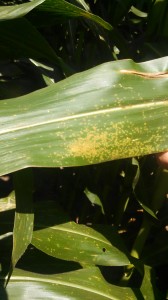The corn growing season has been near ideal so far. If we have had a fertilizer leaching rain event since the first of March, I can’t remember it. We know that the high rates of sunshine (and photosynthesis) in dry years typically lead to our best corn yields with good irrigation management. Except in minor cases, disease incidence has been low in my observations. I hosted a “Self-Guided Corn Tour” this week and continue to be optimistic about the potential of this crop. However, Southern Corn Rust which we know can be an aggressive and costly disease is showing up locally.
I encourage corn growers to do the following NOW:
1. Contact your seedsman and ask about the susceptibility of the hybrids on your farm.
2. Scout your corn fields and identify disease incidence levels.
3. If you applied fungicide to your cornfields 14+ days ago, check them again. This farm was treated once, 15 days previously.
We learned a great deal in 2014 about the susceptibility of the most popular corn hybrids grown in the southeast and the potential yield impacts. Let this experience work for you and consider the risks of Southern rust very real to your successful corn production.The optimum conditions for rust development are temperatures from 80 to 90 degrees F and high humidity. Yield loss can be severe especially when corn is planted late and environmental conditions are favorable for disease development.

